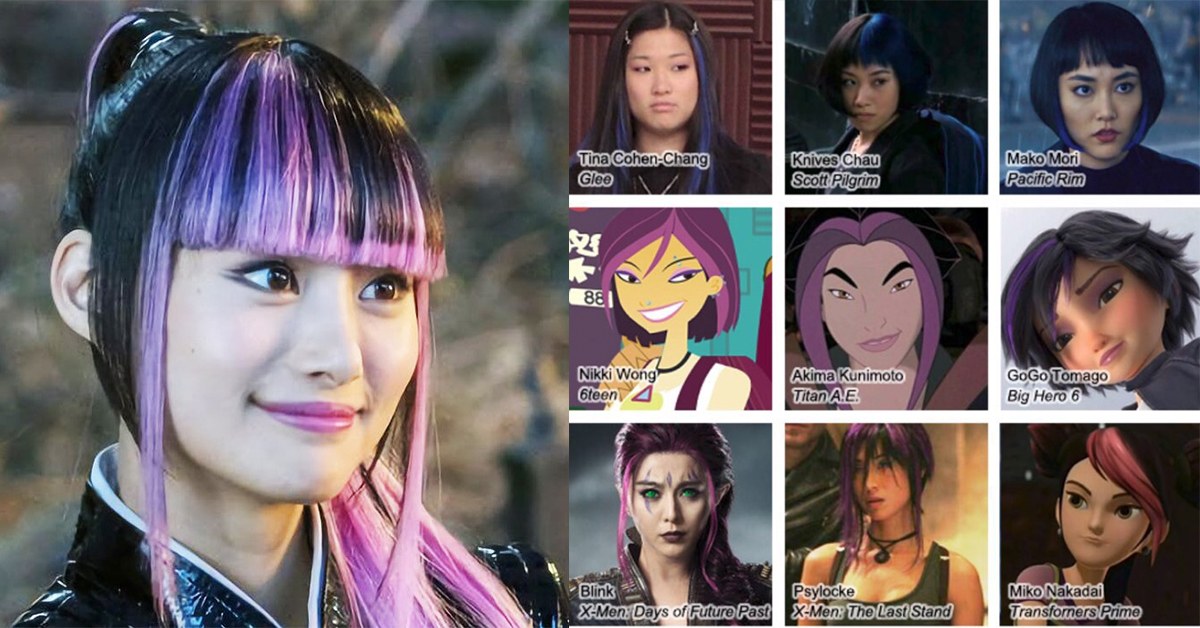It's Time to Retire the 'Hairstreak Asian' Trope

It’s no secret that Asians get short shrift in Hollywood. Up until quite recently, any Asian character who didn’t do kung-fu, play a nerd, or wear a kimono felt like a win. But even with the progress that’s brought more nuanced, realistic Asian representation on-screen, there are still seedy stereotypes making their way into films, particularly when it comes to Asian women. Take Deadpool 2‘s Yukio, the Asian girlfriend of X-Men member Negasonic Teenage Warhead. While the relationship itself is a big step in the right direction for queer Asian visibility, Yukio’s pink-streaked hair still upholds a cheap trope—that is, that all an Asian woman needs to be subversive or bold is a colorful chunk of hair.
For years, Asian women have been stereotyped as quiet, passive, and compliant. They’re often powerless. And racially-charged terms like “China Doll” and “Geisha Girl” only stand to support this stereotype, as though Asian women are meant to be visually appealing and—well, that’s about it. (Not to mention “Dragon Lady,” which is tied to the other stereotype of hyper-sexualized and fetishized Asian women.) This streak of color in otherwise jet-black hair is a newer extension, one intended to indicate that the woman is rebellious, a badass, or both. It’s particularly insidious because it’s so a) pervasive and b) subtle.
But every time an Asian woman with a streak of color in her hair appears on the screen, the same meme makes the rounds calling out the film or TV show in question, as Racked pointed out in late 2017. It seems things haven’t changed since then, and Twitter is mad.
https://twitter.com/resurgentroses/status/999734433828622338
https://twitter.com/theonlyChristus/status/998799004812144641
https://twitter.com/TheSilentRiver/status/998741567803351040
I personally find this problematic, but not to the degree where I’d descend into a dizzying rage spiral, as I did with Nicki Minaj’s Chun Lee shtick. Other Asians and Asian-Americans seem to have similarly mixed feelings on social media—so I asked a few of my (Asian) friends for their take on the matter.
“I’m of two minds about this,” says my friend Mallory, 29, a data scientist in San Francisco. “I have noticed this before. But since Asian characters [who have it] usually show up in comic book movies, or some form of the genre, it didn’t seem super out of place. I always wanted to color my hair growing up because of Rogue from X-Men.” Comics, video games, and anime do lend themselves more to bold hair colors. (Though it’s worth noting that in the Marvel comics, Yukio’s hair is jet-black and streak-free.) And hair color is a popular, easy way for Asian women to express themselves. “When I first started working, I wanted to stand out, so my hair stylist suggested that I dye my hair,” says Yun, 30, a publicist in New York City. “I wasn’t ready to go completely blue or what-not, so we settled on a streak and that sort of became my signature.”
Of course, hair color can be a fun, effective symbol of rebellion—and frankly, you’re free to do whatever you want with your hair. The more recent, real-life trend of Asian women coloring or bleaching their hair in order to subvert stereotypes is undoubtedly a good thing. But in movies and shows, hair streaks have become a crutch for higher-ups who can’t otherwise develop complex Asian characters. Instead of fleshing out a three-dimensional character—too much work, maybe—it’s a cheap, lazy way of making certain Asian characters stand out from the so-called demure crowd. All she needs is a few streaks of purple hair, a leather jacket, and an attitude.
Although sometimes, you don’t even get that. “I would like to see [Yukio] talk more,” said Shioli Kutsuna, the actress who played her, in a recent interview. “I would just like to see her character more. It would be great to see her fighting and really show her strength in that aspect.” Her pink streaks could only do so much.
Which takes us back to square one. In the same way historical stereotypes like quiet “China Dolls” and wily “Dragon Ladies” reduce Asian women, putting a streak of color in an Asian character’s hair to designate her as “rebellious” excuses her development as a truly powerful, complex character. Now, she’s still minimized, but this time as the visual, exoticized version of the Manic Pixie Dream Girl—a whole new stereotype of its own.
One solution would be to include Asians in more non-race-specific roles. “For the film industry, I think this hair streak thing would not exist if Asian actors were just in more stuff,” explains Mallory. “I.e., you’re not going to see a Chinese character in Wolf of Wall Street with a hair streak—hopefully.” We’re guessing that that may take awhile. But there’s one small consolation: At least we have Crazy Rich Asians to look forward to.
Related Stories:
–At the Korean Spa, $40 Gets Me a Body Scrub and Self-Acceptance
–For Women of Color, Hotel Shampoo Isn’t Just Meh—It’s Literally Unusable
–‘Cool Blond Asians’ Are Giving Me an Identity Crisis
